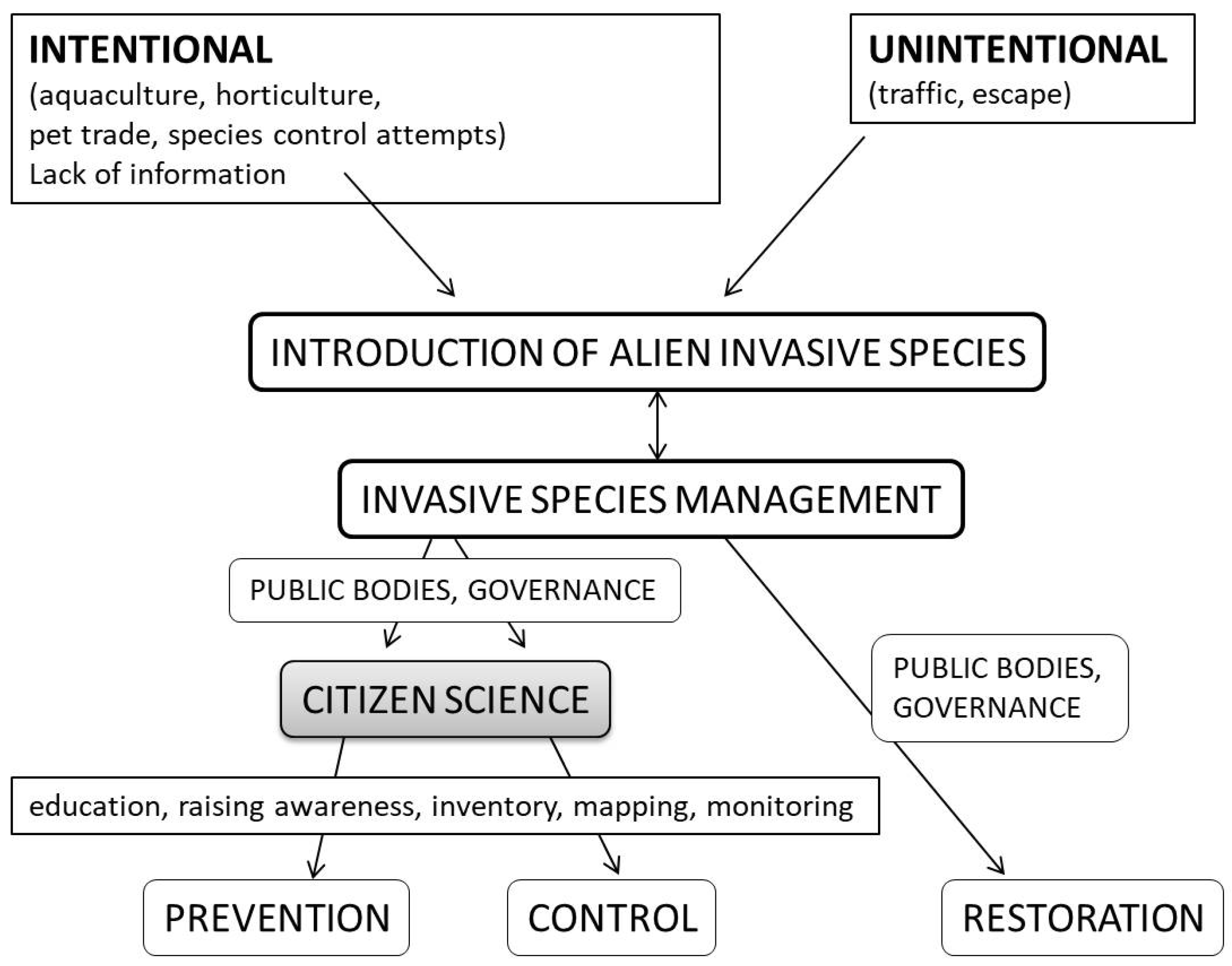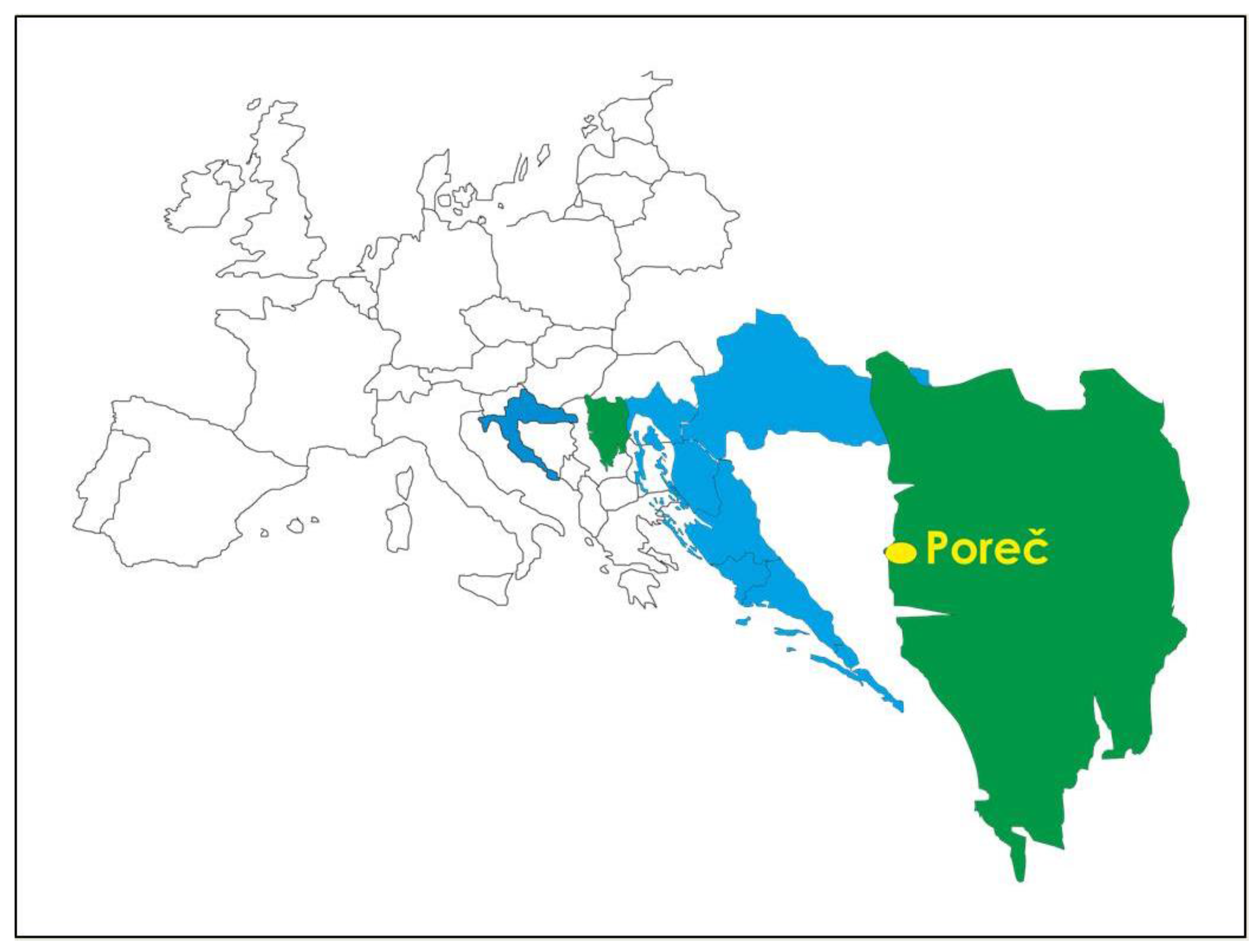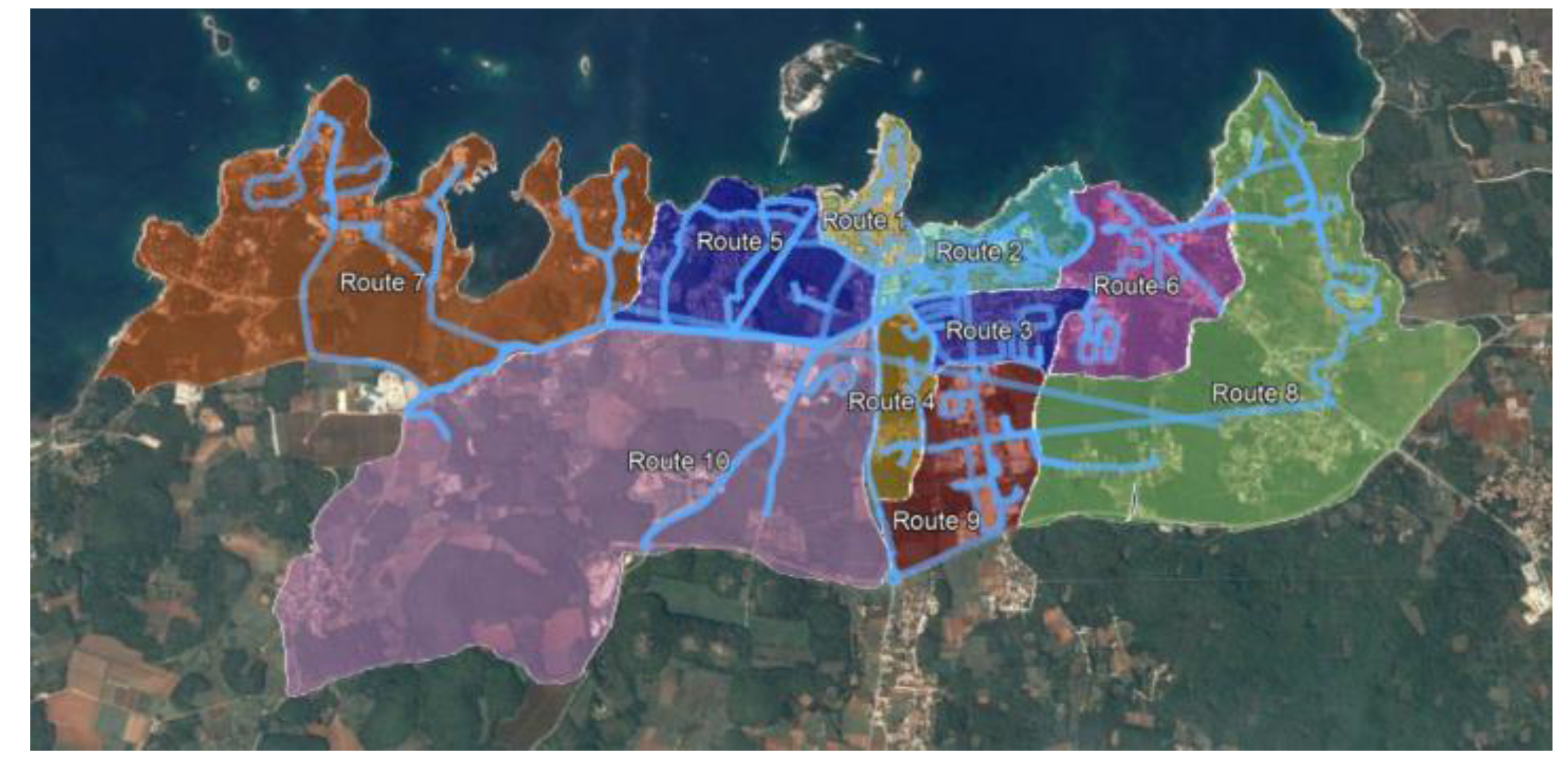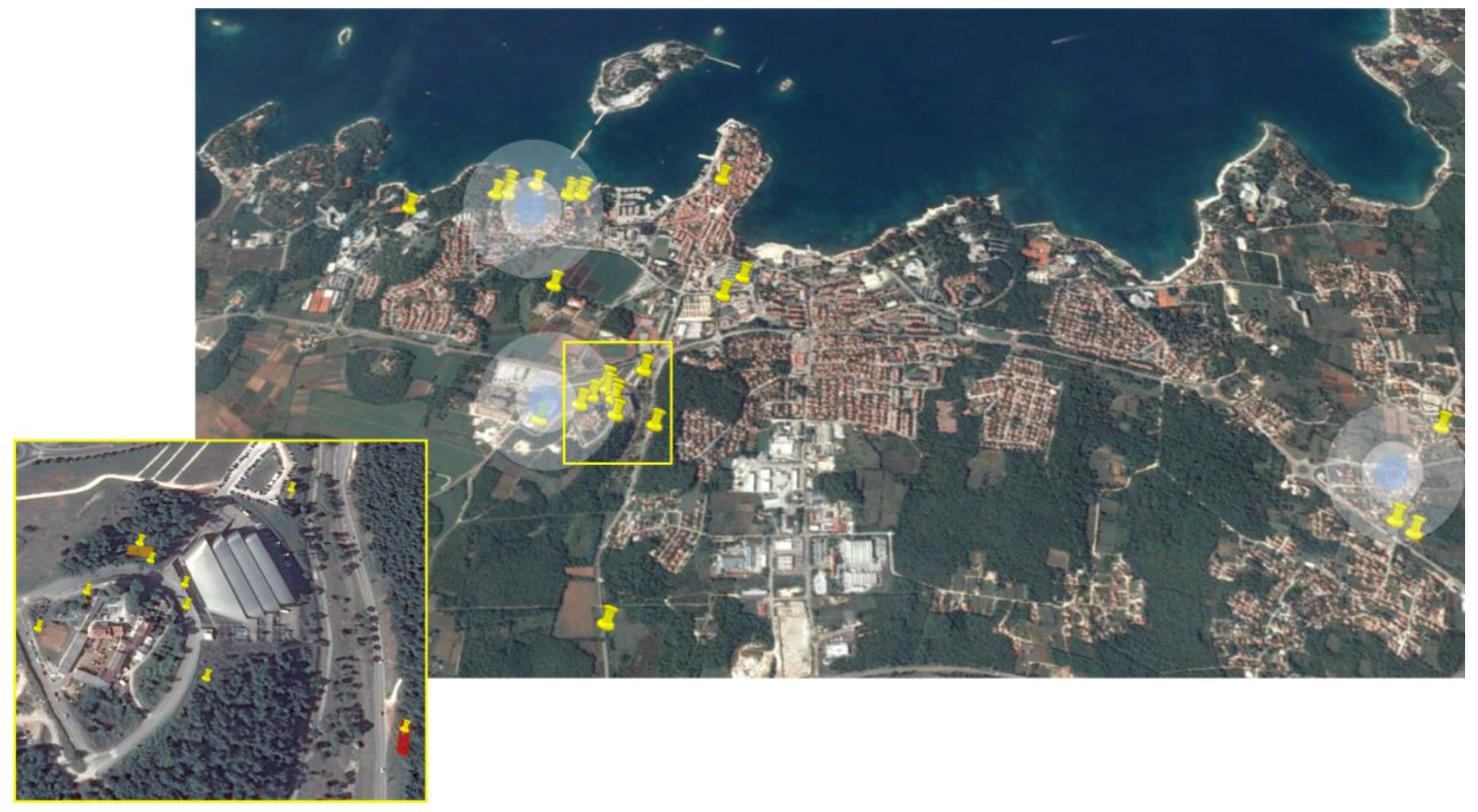Citizen Science as a Tool in Biological Recording—A Case Study of Ailanthus altissima (Mill.) Swingle
Abstract
:1. Introduction
Case Study—Biological Recording of Ailanthus altissima
2. Materials and Methods
2.1. Case Study—Biological Recording of Ailanthus altissima
2.2. Citizen Science in Biological Recording
2.3. Mapped Areas
2.4. Harmfulness Assessment
3. Results and Discussion
3.1. Surveyed Areas
3.2. Harmfulness
4. Conclusions
Acknowledgments
Author Contributions
Conflicts of Interest
References
- Landenberger, R.E.; Warner, T.A.; McGraw, J.B. Spatial patterns of female Ailanthus altissima across and urban-to-rural land use gradient. Urban Ecosyst. 2009, 12, 437–448. [Google Scholar] [CrossRef]
- Millennium Ecosystem Assessment. Ecosystems and Human Well-Being: Synthesis; Island Press: Washington, DC, USA, 2005. [Google Scholar]
- Zisenis, M. EU DAISIE Research Project: Wanted-death penalty to keep native species competitive? J. Agric. Environ. Ethics 2012, 25, 597–606. [Google Scholar] [CrossRef]
- Zisenis, M. Alien plant species: A real fear for urban ecosystems in Europe. Urban Ecosyst. 2015, 18, 355–370. [Google Scholar] [CrossRef]
- Kowarik, I.; Säumel, I. Biological flora of Central Europe: Ailanthus altissima (Mill.) Swingle. Perspect. Plant Ecol. 2007, 8, 207–237. [Google Scholar] [CrossRef]
- Cousins, M.C.; Briggs, J.; Gresham, C.; Whetstone, J.; Whitwell, T. Beach vitex (Vitex rotundifolia): An invasive coastal species. Invasive Plant Sci. Manag. 2010, 3, 340–345. [Google Scholar] [CrossRef]
- Peacock, D.; Abbott, I. The mongoose in Australia: Failed introduction of a biological control agent. Aust. J. Zool. 2010, 58, 205–227. [Google Scholar] [CrossRef]
- Meinesz, A.; de Vaugelas, J.; Hesse, B.; Mari, X. Spread of the introduced tropical green alga Caulerpa taxifolia in northern Mediterranean waters. J. Appl. Phycol. 1993, 5, 141. [Google Scholar] [CrossRef]
- Courtenay, W.R. Marine fish introductions in southeastern Florida. Am. Fish. Soc. Introd. Fish Sect. Newsl. 1995, 14, 2–3. [Google Scholar]
- Meshaka, W.E., Jr.; Loftus, W.F.; Steiner, T. The herpetofauna of Everglades National Park. Fla. Sci. 2000, 63, 84–103. [Google Scholar]
- Couvet, D.; Jiguet, F.; Julliard, R.; Levrel, H.; Teyssedre, A. Enhancing citizen contributions to biodiversity science and public policy. Interdiscip. Sci. Rev. 2008, 33, 95–103. [Google Scholar] [CrossRef]
- Lee, T. Evaluating the Contribution of Citizen Participation in Research to Understand Wildlife Movement across Highway 3 in Crowsnest Pass, Alberta. Master’s Thesis, University of Calgary, Calgary, AB, Canada, 2007. [Google Scholar]
- Ferster, C.J.; Coops, N.C.; Harshaw, H.W.; Kozak, R.A.; Meitner, M.J. An exploratory assessment of a smartphone application for public participation in forest fuels measurement in the wildland-urban interface. Forests 2013, 4, 1199–1219. [Google Scholar] [CrossRef]
- Sladonja, B.; Brščić, K.; Poljuha, D.; Fanuko, N.; Grgurev, M. Introduction of participatory conservation in Croatia, residents’ perceptions: A case study from the Istrian Peninsula. Environ. Manag. 2012, 49, 1115–1129. [Google Scholar] [CrossRef] [PubMed]
- Lyons, J.R. Urban ecosystem management: Bringing science and policy together. Urban Ecosyst. 1997, 1, 77–83. [Google Scholar] [CrossRef]
- Lodge, D.M.; Williams, S.; Mac Isaac, H.J.; Hayes, K.R.; Leung, B.; Reichard, S.; Mack, R.N.; Moyle, P.B.; Smith, M.; Andow, D.A.; et al. Biological invasions: Recommendations for US policy and management. Ecol. Appl. 2006, 16, 2035–2054. [Google Scholar] [CrossRef]
- Suomela, T.; Johns, E. Citizen Participation in the Biological Sciences: A Literature Review of Citizen Science. 2012. Available online: http://trace.tennessee.edu/cgi/viewcontent.cgi?article=1048&context=ccisymposium (accessed on 13 April 2017).
- Crall, A.W.; Jarnevich, C.S.; Young, N.E.; Panke, B.J.; Renz, M.; Stohlgren, T.J. Citizen science contributes to our knowledge of invasive plant species distributions. Biol. Invasions 2015, 17, 2415–2427. [Google Scholar] [CrossRef]
- DAISIE (2014) Delivering Alien Invasive Species Inventories for Europe (DAISIE). Available online: http://www.europe-aliens.org/species TheWorst.do (accessed on 13 April 2017).
- NISIC, USDA (2014) National Invasive Species Information Centre. Available online: http://www.invasivespeciesinfo.gov/plants/treeheaven.shtml (accessed on 24 April 2015).
- South Africa. Conservation of Agricultural Resources Act, 1983; Government Printing Works: Pretoria, South Africa, 1983.
- Sladonja, B.; Sušek, M.; Guillermic, J. Review on invasive Tree of Heaven (Ailanthus altissima (Mill.) Swingle) conflicting values: Assessment of its ecosystem services and potential biological threat. Environ. Manag. 2015, 56, 1009–1034. [Google Scholar] [CrossRef] [PubMed]
- Williams, W.H.; Morin, R.S.; Johnson, K.; Moser, W.K.; Westfall, J.A. Invasive plant monitoring for Northern U.S. forests. In Proceedings of the Moving from Status to Trends: Forest Inventory and Analyses Symposium, Baltimore, MD, USA, 4–6 December 2012; pp. 283–287. [Google Scholar]
- Casella, F.; Vurro, M. Ailanthus altissima (tree of heaven): Spread and harmfulness in a case-study urban area. Arboricult. J. Int. J. Urban For. 2013, 35, 172–181. [Google Scholar] [CrossRef]
- Zimmermann, H.; Loos, J.; von Wehrden, H.; Fischer, J. Aliens in Transylvania: Risk maps of invasive alien plant species in Central Romania. NeoBiota 2015, 24, 55–65. [Google Scholar] [CrossRef]
- Idžojtić, M.; Zebec, M. Distribution of the tree of heaven (Ailanthus altissima /Mill./Swingle) and spreading of invasive woody alien species in Croatia. Glasnik za Šumske Pokuse 2006, 5, 315–323. (In Croatian) [Google Scholar]
- Novak, M.; Novak, N. Distribution of invasive alien species tree of heaven (Ailanthus altissima (Mill.) Swingle) by the Croatian counties. Glasilo Biljne Zaštite 2017, 17, 329–337. (In Croatian) [Google Scholar]
- Boršić, I.; Desnica, S.; Kutleša, P. Planned activities on management of tree of heaven (Ailanthus altissima (Mill.) Swingle, Simaroubaceae) in Croatia. In Programme & Book of Abstracts EMAP 14 Ecology and Management of Alien Plant Invasions—Syntheses, Challenges and New Opportunities; Maguas, C., Crous, C., Costa, C., Eds.; Centre for Ecology, Evolution and Environmental Changes—cE3c: Lisabon, Portugal, 2017; p. 167. [Google Scholar]
- Novak, N.; Lodeta, V.; Sušić, G.; Radek, V. Tree of Heaven (Ailanthus altissima (Mill.) Swingle)—Invasive alien species in Croatia. In Proceedings of the World Conference on Biological Invasions and Ecosystem Functioning, Porto, Portugal, 27–30 October 2009. [Google Scholar]
- Pelješac News. Available online: http://peljesacnews.com/terenska-radionica-ekoloska-udruga-mala-sirena-zuljana/ (accessed on 20 October 2015). (In Croatian).
- Hernandez-Stefanoni, J.L.; Ponce-Hernandez, R. Mapping the spatial variability of plant diversity in a tropical forest: Comparison of spatial interpolation methods. Environ. Monit. Assess. 2006, 117, 307–334. [Google Scholar] [CrossRef] [PubMed]
- MacAvoy, T.J.; Snyder, A.L.; Johnson, N.; Salom, S.M.; Kok, L.T. Road survey of the invasive Tree-of-heaven (Ailanthus altissima) in Virginia. Invasive Plant Sci. Manag. 2012, 5, 506–512. [Google Scholar] [CrossRef]
- Roura-Pascual, N.; Krug, R.M.; Richardson, D.M.; Hui, C. Spatially-explicit sensitivity analysis for conservation management exploring the influence of decisions in invasive alien plant management. Divers. Distrib. 2010, 16, 426–438. [Google Scholar] [CrossRef]
- Rundel, P.W.; Dickie, I.A.; Richardson, D.M. Tree invasions into treeless areas: Mechanisms and ecosystem processes. Biol. Invasions 2014, 16, 663–675. [Google Scholar] [CrossRef]
- Wilson, J.R.U.; Caplat, P.; Dickie, I.A.; Hui, C.; Maxwell, B.D.; Nuñez, M.A.; Pauchard, A.; Rejmánek, M.; Richardson, D.M.; Robertson, M.P.; et al. A standardized set of metrics to assess and monitor tree invasions. Biol. Invasions 2014, 16, 535–551. [Google Scholar] [CrossRef]
- Visser, V.; Langdon, B.; Pauchard, A.; Richardson, D.M. Unlocking the potential of Google Earth as a tool in invasion science. Biol. Invasions 2014, 16, 513–534. [Google Scholar] [CrossRef]
- Pettorelli, N.; Schulte to Bühne, H.; Tulloch, A.; Dubois, G.; Macinnis-Ng, C.; Queirós, A.M.; Keith, D.A.; Wegmann, M.; Schrodt, F.; Stellmes, M.; et al. Satellite remote sensing of ecosystem functions: Opportunities, challenges and way forward. Remote Sens. Ecol. Conserv. 2017. [Google Scholar] [CrossRef]
- Ransom, C.V.; Olsen, H.E. Mapping invasive plants using a helmet based video system. In Proceedings of the Western Society of Weed Science Meeting, Portland, OR, USA, 9–12 March 2015. [Google Scholar]
- Savage, N. Made to measure. Nature 2015, 527, S12–S13. [Google Scholar] [CrossRef] [PubMed]
- Zandbergen, P.A.; Barbeau, S.J. Positional accuracy of assisted GPS data from high-sensitivity GPS-enabled mobile phones. J. Navig. 2011, 64, 381–399. [Google Scholar] [CrossRef]
- Ortega, Y.K.; Pearson, D.E. Weak vs. strong invaders of natural plant communities: Assessing invasibility and impact. Ecol. Appl. 2005, 15, 651–661. [Google Scholar] [CrossRef]
- Rebbeck, J.; Hutchinson, T.; Iverson, L.; Yaussy, D.; Fox, T. Distribution and demographics of Ailanthus altissima in an oak forest landscape managed with timber harvesting and prescribed fire. For. Ecol. Manag. 2017, 401, 233–241. [Google Scholar] [CrossRef]
- Csete, Á.K.; Tanács, E.; Gulyás, Á. Assessment of Tree of Heaven (Ailanthus altissima) spread dynamics on example of Szeged (Hungary). Acta Climatologica et Chorologica 2016, 49–50, 9–20. [Google Scholar]
- Pocock, M.J.; Roy, H.E.; Preston, C.D.; Roy, D.B. The Biological Records Centre: A pioneer of citizen science. Biol. J. Linn. Soc. 2015, 115, 475–493. [Google Scholar] [CrossRef] [Green Version]
- Roy, H.E.; Rorke, S.L.; Beckmann, B.; Booy, O.; Botham, M.S.; Brown, P.M.; Harrower, C.; Noble, D.; Sewell, J.; Walker, K. The contribution of volunteer recorders to our understanding of biological invasions. Biol. J. Linn. Soc. 2015, 115, 678–689. [Google Scholar] [CrossRef]
- Pescott, O.L.; Walker, K.J.; Pocock, M.J.; Jitlal, M.; Outhwaite, C.L.; Cheffings, C.M.; Harris, F.; Roy, D.B. Ecological monitoring with citizen science: The design and implementation of schemes for recording plants in Britain and Ireland. Biol. J. Linn. Soc. 2015, 115, 505–521. [Google Scholar] [CrossRef]
- Jordan, R.C.; Brooks, W.R.; Howe, D.V.; Ehrenfeld, J.G. Evaluating the performance of volunteers in mapping invasive plants in public conservation lands. Environ. Manag. 2012, 49, 425–434. [Google Scholar] [CrossRef] [PubMed]
- Xie, Y.; Sha, Z.; Yu, M. Remote sensing imagery in vegetation mapping: A review. J. Plant Ecol. 2013, 1, 9–23. [Google Scholar] [CrossRef]
- Joshi, C.M.; de Leeuw, J.; van Duren, I.C. Remote sensing and GIS applications for mapping and spatial modelling of invasive species. Proc. ISPRS 2004, 35, B7. [Google Scholar]
- Asner, G.P.; Vitousek, P.M. Remote analysis of biological invasion and biogeochemical change. Proc. Natl. Acad. Sci. USA 2005, 102, 4383–4386. [Google Scholar] [CrossRef] [PubMed]
- Joshi, C.; Leeuw, J.D.; van Andel, J.; Skidmore, A.K.; Lekhak, H.D.; van Duren, I.C.; Norbu, N. Indirect remote sensing of a cryptic forest understory invasive species. For. Ecol. Manag. 2006, 225, 245–256. [Google Scholar] [CrossRef]
- Jay, S.; Lawrence, R.; Repasky, K.; Keith, C. Invasive species mapping using low cost hyperspectral imagery. In Proceedings of the ASPRS Annual Conference, Baltimore, MD, USA, 9–13 March 2009. [Google Scholar]
- Narumalani, S.; Mishra, D.R.; Wilson, R.; Reece, P.; Kohler, A. Detecting and mapping four invasive species along the floodplain of North Platte River, Nebraska. Weed Technol. 2009, 23, 99–107. [Google Scholar] [CrossRef]
- Mergen, F. A toxic principle in the leaves of Ailanthus. Bot. Gaz. 1959, 121, 32–36. [Google Scholar] [CrossRef]
- Heisey, R.M. Identification of an allelopathic compound from Ailanthus altissima (Simaroubaceae) and characterization of its herbicidal activity. Am. J. Bot. 1996, 83, 192–200. [Google Scholar] [CrossRef]
- Bory, G.; Clair-Maczulajtys, D. Production, dissémination et polymorphisme des semences d’Ailanthus altissima (Mill.) Swingle, Simaroubacées. Rev. Gen. Bot. 1980, 88, 297–311. (In French) [Google Scholar]
- Lawrence, J.G.; Colwell, A.; Sexton, O.J. The ecological impact of allelopathy in Ailanthus altissima (Simaroubaceae). Am. J. Bot. 1991, 78, 948–958. [Google Scholar] [CrossRef]
- Ballero, M.; Ariu, A.; Falagiani, P.; Piu, G. Allergy to Ailanthus altissima (tree of heaven) pollen. Allergy 2003, 58, 532–533. [Google Scholar] [CrossRef] [PubMed]
- Burrows, G.E.; Tyrl, R.J. Toxic Plants of North America, 2nd ed.; Wiley-Blackwell: Hoboken, NJ, USA, 2013. [Google Scholar]
- Agricola, I. Un Alleato del Pioppo: L’ailanto. Anno XVI. 15 August 1936, N. 15: 328–329. In Proceedings of the XXth ISPRS Congress: Geo-Imagery Bridging Continents (ISPRS 2004), Istanbul, Turkey, 12–23 July 2004; Volume 7, pp. 669–677. [Google Scholar]
- Barnett, D.T.; Stohlgren, T.J.; Jarnevich, C.S.; Chong, G.W.; Ericson, J.A.; Davern, T.R.; Simonson, S.E. The art and science of weed mapping. Environ. Monit. Assess. 2007, 132, 235–252. [Google Scholar] [CrossRef] [PubMed]
- Celesti-Grapow, L.; Blasi, C. The role of alien and native weeds in the deterioration of archaeological remains in Italy. Weed Technol. 2004, 18, 1508–1513. [Google Scholar]
- Constán-Nava, S. Ecología de la especie invasora Ailanthus altissima (Mill.) Swingle. Bases para su control y erradicación en espacios naturales protegidos. Ecosistemas 2013, 22, 83–85. (In Spanish) [Google Scholar]
- Badalamenti, E.; LaMantia, T. Stem-injection of herbicide for control of Ailanthus altissima (Mill.) Swingle: A practical source of power for drilling holes in stems. iFor.-Biogeosci. For. 2013, 6, 123–126. [Google Scholar] [CrossRef]
- Wickert, K.L.; O’Neal, E.S.; Davis, D.D.; Kasson, M.T. Seed production, viability, and reproductive limits of the invasive Ailanthus altissima (Tree-of-Heaven) within invaded environments. Forests 2017, 8, 226. [Google Scholar] [CrossRef]
- Kahn, A. The Tyranny of small decisions: Market failures, imperfections, and the limits of economics. Kyklos 1966, 19, 23–47. [Google Scholar] [CrossRef]
- Odum, W. Environmental degradation and the tyranny of small decisions. Bioscience 1982, 32, 728–729. [Google Scholar] [CrossRef]
- Cooper, C.B.; Dickinson, J.; Phillips, T.; Bonney, R. Citizen science as a tool for conservation in residential ecosystems. Ecol. Soc. 2007, 12, 11. [Google Scholar] [CrossRef]
- Luz Lezcano Caceres, H.; Gerold, G. The cost of invasion control measures subtropical Ailanthus altissima (Mill) Swingle in Hesse. In Tropentag, Conference on International Research on Food Security, Natural Resource Management and Rural Development; Tielkes, E., Ed.; Book of abstracts; University of Hamburg: Hamburg, Germany, 2009. [Google Scholar]
- Kapoor, I. Towards participatory environmental management. Environ. Manag. 2001, 63, 269–279. [Google Scholar] [CrossRef] [PubMed]
- Ajiboye, J.O.; Silo, N. Enhancing Botswana children’s environmental knowledge, attitudes and practices through the School Civic Club. Int. J. Environ. Sci. Educ. 2008, 3, 105–114. [Google Scholar]
- Nali, C.; Lorenzini, G. Air quality survey carried out by schoolchildren: An innovative tool for urban planning. Environ. Monit. Assess. 2007, 131, 201–210. [Google Scholar] [CrossRef] [PubMed]





| Route | Type | Length (km) | Infested Areas (Number) | Infested Area (m2) | ||||||
|---|---|---|---|---|---|---|---|---|---|---|
| Plants (Number) * | Polygons (Number) ** | |||||||||
| D1 | D2 | D3 | D4 | Sparse | Dense | Very Dense | ||||
| 1 | Urban | 4.2 | 0 | 0 | 0 | 0 | 0 | 1 | 0 | 24 |
| 2 | Urban | 8.82 | 0 | 0 | 0 | 0 | 1 | 1 | 0 | 8 |
| 3 | Urban | 5.02 | 0 | 0 | 0 | 0 | 0 | 0 | 0 | 0 |
| 4 | Urban | 5.63 | 0 | 0 | 0 | 0 | 0 | 0 | 1 | 300 |
| 5 | Urban | 8.38 | 2 | 1 | 2 | 3 | 3 | 3 | 1 | 655 |
| 6 | Urban | 8.73 | 0 | 0 | 0 | 0 | 0 | 0 | 0 | 0 |
| 7 | Sub urban | 23.10 | 0 | 0 | 0 | 0 | 0 | 0 | 0 | 0 |
| 8 | Sub urban | 11.38 | 1 | 1 | 2 | 1 | 0 | 1 | 2 | 284 |
| 9 | Industrial | 10.92 | 0 | 0 | 0 | 1 | 0 | 0 | 1 | 80 |
| 10 | Industrial | 4.43 | 3 | 2 | 1 | 0 | 1 | 3 | 0 | 1259 |
| Total | 90.61 | 6 | 4 | 5 | 5 | 5 | 9 | 5 | 2610 | |
| Type of Effect | Site * | Number of Findings |
|---|---|---|
| Functional | ||
| Infestation of driveways and parking places | U/SU | 2 |
| Infestation of roads | SU/I | 2 |
| Walkways obstruction | SU/I | 2 |
| Difficulty in visualisation of road signs | SU/I | 7 |
| Reduced visibility on the road | U/SU/I | 8 |
| Physical and chemical damage to architectural, historic, artistic, and archaeological objects | U | 1 |
| Damage to building construction | I | 1 |
| Damage to power lines | I | 1 |
| Damage to fences and railings | U/I | 5 |
| Difficulty in maintenance of green areas | U | 2 |
| Difficulty in maintenance of facilities | U/I | 5 |
| Disorders in horticulture planning in tourist areas | U | 1 |
| Environmental | ||
| * Loss of biodiversity | U | 6 |
| * Habitat alteration | U/I | 18 |
| * Habitat degradation | SU | 1 |
| Safety and health | ||
| Hazards caused by the reduction of drivers’ views | U | 1 |
| Hazards caused by reduced visibility on crossroads and roundabouts | SU | 6 |
| Damage to pavements and footpaths | SU/I | 2 |
| * Appearance of allergy symptoms | SU/I | 39 |
| Aesthetic | ||
| Aesthetic damage of archaeological sites | U | 1 |
| Damage to public and private green areas | U/SU/I | 21 |
| Vegetation anthropisation—landscape monotony | I | 1 |
| Aesthetic damage to tourist or residential areas | U | 1 |
© 2018 by the authors. Licensee MDPI, Basel, Switzerland. This article is an open access article distributed under the terms and conditions of the Creative Commons Attribution (CC BY) license (http://creativecommons.org/licenses/by/4.0/).
Share and Cite
Sladonja, B.; Poljuha, D. Citizen Science as a Tool in Biological Recording—A Case Study of Ailanthus altissima (Mill.) Swingle. Forests 2018, 9, 31. https://doi.org/10.3390/f9010031
Sladonja B, Poljuha D. Citizen Science as a Tool in Biological Recording—A Case Study of Ailanthus altissima (Mill.) Swingle. Forests. 2018; 9(1):31. https://doi.org/10.3390/f9010031
Chicago/Turabian StyleSladonja, Barbara, and Danijela Poljuha. 2018. "Citizen Science as a Tool in Biological Recording—A Case Study of Ailanthus altissima (Mill.) Swingle" Forests 9, no. 1: 31. https://doi.org/10.3390/f9010031
APA StyleSladonja, B., & Poljuha, D. (2018). Citizen Science as a Tool in Biological Recording—A Case Study of Ailanthus altissima (Mill.) Swingle. Forests, 9(1), 31. https://doi.org/10.3390/f9010031






